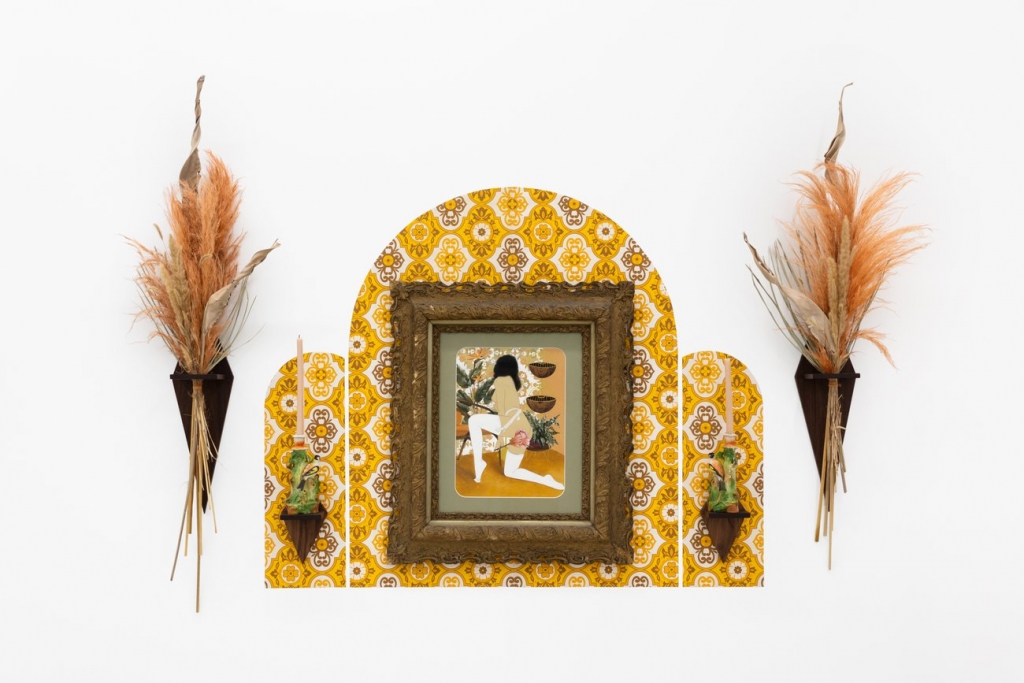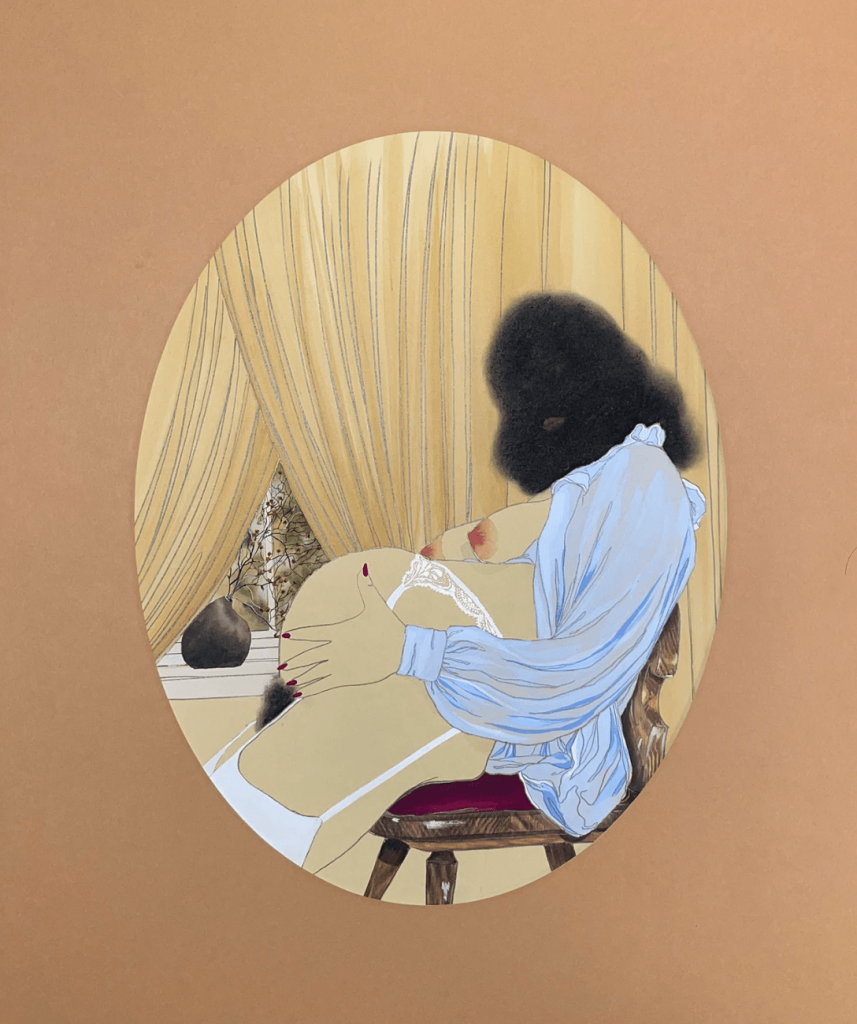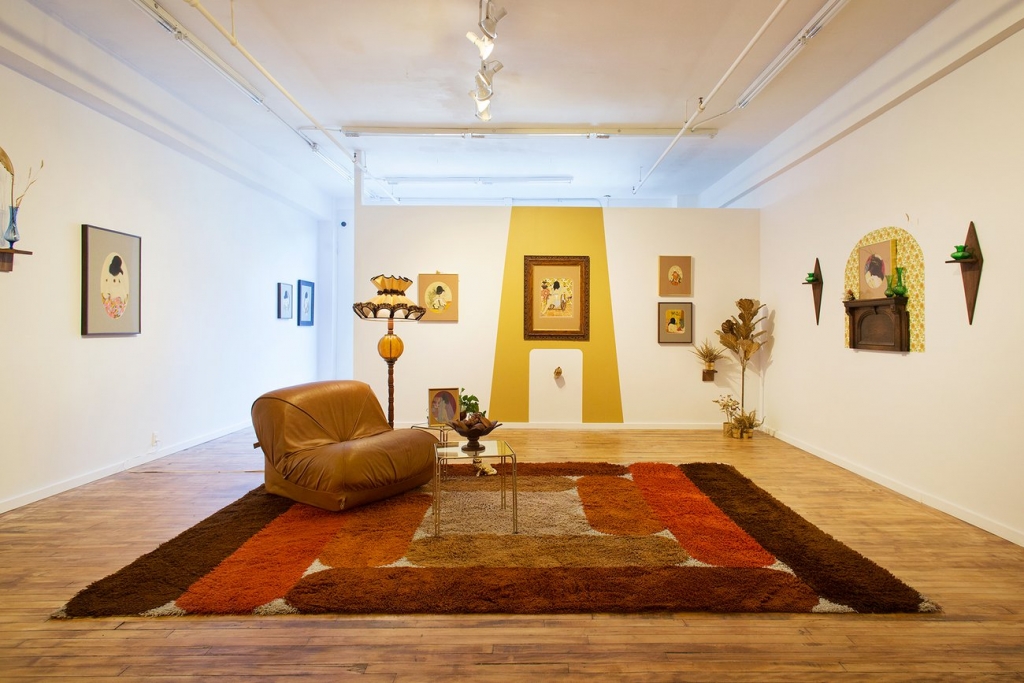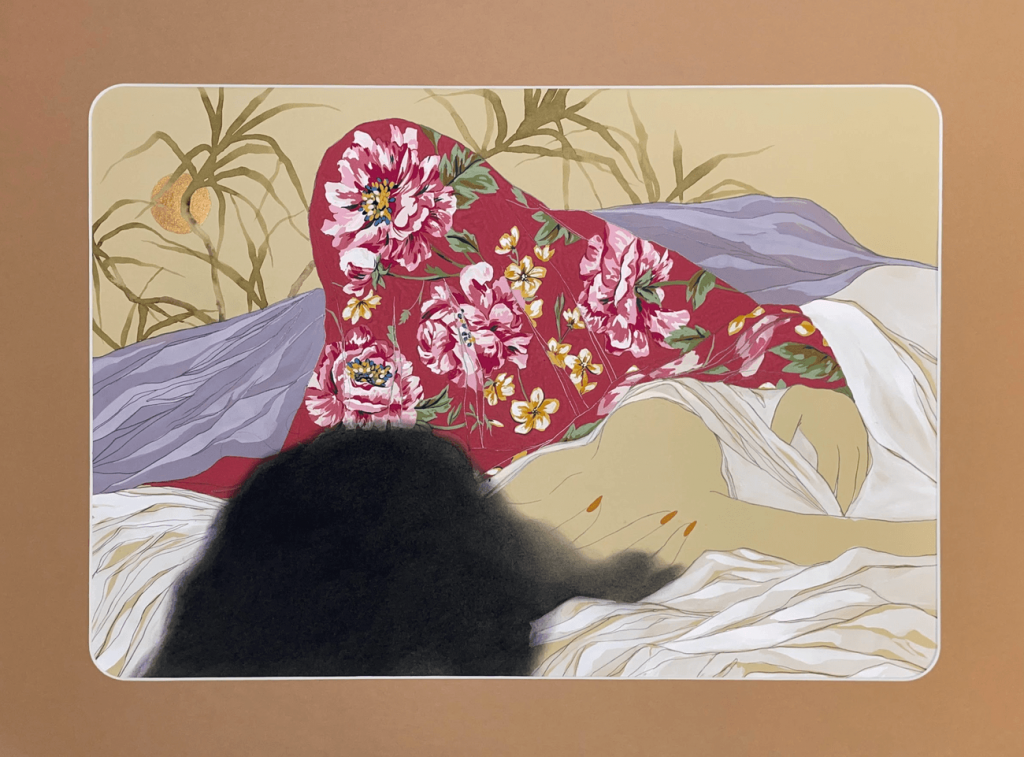
Mia Sandhu is a Punjabi-Canadian artist, born in Canada, currently residing in Toronto. She is an artist who often works with issues of immigration, identity, femininity, and sensuality. Seeing You, Seeing Me, Seeing You was Patel Brown’s second exhibition at their Montreal gallery, and Sandhu’s first solo exhibition in Montreal. These works explore, among other things, the relationship between pleasure and shame. Her figures appear to be at ease with their bodies, confident in their sexuality, at home in their environment and being seen. Perhaps they are so relaxed because some of their most personal physical features, their faces and genitals, are obscured by clouds of black smoke-like veils. The exhibition consists of many works on paper, made with gouache, watercolour, pencil, and charcoal. Paintings on paper are surrounded by vintage furniture (loaned from the personal collection of Patel Brown Montreal gallery director Roxanne Arsenault) and installation elements that create a homey, stylish, and pleasantly kitschy environment for her works. Her inspiration here comes from her collection of vintage erotica, her work as a set painter in the film industry, and her family photos from the seventies, all of which contribute to the aesthetic.
I first discovered Mia Sandhu’s work at the Patel Brown booth at the Papier Art Fair a few years ago in Montreal. I remember her work as exemplary in the use of materials, and striking in her portrayal of the erotic. It was a breath of fresh air at an art fair where senses are overloaded, making a lot of work seem underwhelming. Sandhu’s works on paper stood out and I was delighted to find them again at the fair in the following years. Patel Brown is a welcome new addition to the galleries in the Belgo Building, as an established gallery that is strongly curated, very contemporary, with a brave sensibility that doesn’t shy away from the erotic and the weird, traits which aren’t that common in Canadian art spaces. As a Punjabi-Canadian of mixed cultural identity, and Sandhu’s works have long examined cultural hybridity. Her work often conveys mixed feelings and experiences, dealing with polarities such as shame and self-love, belonging and alienation.

The women in these paintings continue the connection to Sandhu’s last solo show at Patel Brown in Toronto, Golden Girls, except here, the figures are often pregnant, and the overall feel here is more erotic and bizarre. Luxuriating in their own feminine power and grace, bedecked in vintage stockings and heels, sporting full 70s-style bushes, the women seem to be part of a secret sisterhood, perhaps Sapphic, perhaps platonic. They tease us, they enjoy their own existence, and they look at us with the same curiosity with which we regard them. These women see us, the viewer, seeing them. Sandhu’s women are playing up this exchange, legs spread over the arms of a chair, frank gazes meeting ours. These women’s soft, lavish pubic hair mimics the colour and texture of their smoky crowns. Though the smoky veil that enshrouds their visages, these women peer at us with a steady and sometimes flirtatious, sometimes inscrutable regard. There is an erotic exchange of energy in watching and being watched, and these women are disrobed in a way that heightens the eroticism of their bodies and situations. They seem to be fantasy images, yet they are simultaneously beings in and of themselves. Spirits of an idealized 1970s, when free love was the thing and many people had sexual awakenings via breaking down of self or societally imposed sexual mores and conventions.
Many of the women in this series are pregnant, but they seem to be so frankly, ripe with creativity and self-possession. There is no sign of a husband or children around, and the demands of childrearing do not beckon. The sense of the pregnancies in this series seems to be in the way that women are creative goddesses of mystery, rather than possessions intended to extend the tribe and lineage. All of the women who are visibly pregnant in these works seem to be in the last month of their pregnancy, ready to bring new life—new creation—into the world, thereby transforming themselves and the lives of their babies forever. In this way, we are reminded of the artist’s role in bringing new work into the physical realm.

Mia Sandhu has a delicate, skillful touch, a mastery with line that makes one peer closer to admire the skill in the rendering of floral textiles and the details of gorgeous houseplants that surround her figures, enhancing the atmosphere of time and place. There is a pleasant contrast between the opaqueness of gouache with the translucency of watercolour, especially layered here over creamy, warm-coloured paper. I am reminded of the rich history of erotic paintings on paper in Asia, examples of which can be found in humourous Japanese erotica, and often philosophical Chinese paintings, which represent slices of daily life, and the harmony of yin and yang represented in both sexes taking equal pleasure in each other. More importantly is the connection to Sandhu’s own heritage, there is a long tradition of gorgeous erotic paintings on paper in India. Sandhu’s interest in putting her figures in domestic environments, surrounded by bold colour and patterns harkens to the rich history of erotic art in Asia and India, but as a contemporary painter she brings a soft but confident touch, contemporary line and rendering skill, a personal inquiry, and a sense of playful taboo. A woman, especially one raised with an awareness of Eastern culture and mores, would have a keen sense of what is acceptable and not acceptable in terms of sexual expression and modesty. The historical predominance of Christian Anglo-Saxon values on colonial Canada makes this country also not so open to sexual expression, feminine pleasure, or self-possession, feminine sexuality is only acceptable if it is a thing to be consumed and profited from by someone else. Such influences are still quite palpable here today, though of course to a much lesser extent than in the past. I do not doubt that the mixed cultural heritage Sandhu possesses has contributed strongly to her interest in portrayals of concealing and revealing. Probably it the contrast between the two states, the sense of becoming, of transition, that makes these works so compelling.
In A Vessel to Hold 4, a heavily pregnant woman regards herself in the mirror, she seems to be calmly admiring what she sees. The Vessel to Hold paintings speak of the way a mother holds their baby within, and the comforting sensation of being held, and perhaps, to hold one’s own soft, round curves, or that of another. They speak of what it is to nurture and be nurtured, and of the embracing, supportive nature of womanhood and sisterhood. A Vessel to Hold 9, a pregnant woman is attired in a diaphanous blue blouse, her swollen breasts and nipples visible over her large belly, which she holds proudly while regarding us. She seems to ask us to admire what she has made. She sits heavily with physical presence on an antique chair of soft wood and wine-coloured velvet. A Vessel to Hold 10 shows two pregnant nymphs, wearing vintage stockings and lace, luxuriating playfully on a bed lush with blue and white curtains, from which wild Queen Anne’s Lace flowers emerge. Sandhu’s pregnant vixens do not allow for the Madonna and whore duality, they convey the sexy magic of a voluptuous pregnant woman, who can still be desired and desire even though she is a mother-to-be.

In the Chrysalis paintings, the figures are again covered with thick black smoke, but they are wearing transparent fabric, perhaps gauze. The title of this mini-series implies they are emerging from silken cocoons, resplendent and transformed. In many Eastern countries, influenced by Muslim traditions, women are veiled, but these chrysalises do not conceal, they reveal the glorious transformation of the feminine body, perhaps from childhood to puberty, then maturity, pregnancy, and beyond. In Chrysalis 6, the curvaceous woman kneels on a bed, regarding us with almost frightful self-possession, eyes just points of piercing light through the darkness. She appears before large golden rings, dried flowers, and plants—familiar as installation elements in this exhibition.
In the Waxing and Waning paintings, women disguised by floral shrouds are paired together to play, support, and embrace each other. Waxing and Waning 16 presents a figure concealed by a floral fabric leaning in to caress a reclining woman whose breast is nearly exposed as she receives a red finger-tipped embrace. The black cloud seems to seep like liquid over the bodies and the bed, almost as if it is an extension of the fluid energy of the couple. Sexual symbolism is apparent in Pussy Willows and Cat Tails, we see the “tail” of the figure, clad in a thong. The bullrushes, or cat tails, look phallic, paired with the delicate toes of the pussy willow branches.
A play on words, and with a nod to popular culture, the bodies in Mia Sandhu’s Bawdy paintings could be considered raucously, joyously nude and lewd. They’re playing in decidedly kitschy 70s environments, enjoying their physical forms and showing off. Full, heavy breasts, costume jewelry, furry armpits, and more greet us. The woman in Bawdy 37 has a leg thrown over the arm of a wicker chair, revealing white panties. She is holding an apple, like Eve, yet shameless. This work is intriguingly presented on a wooden shelf, flanked by retro decorative elements, against a white and mustard-coloured floral patterned wallpaper, almost as a shrine. This style is reflected in Bawdy 36, where a white opaque-stockinged nymph coquettishly draws a stemmed flower between her legs as she kneels on the floor before a chair and houseplants. The painting is flanked by campy candle holders against a different type of vintage-style wallpaper. These works by Sandhu create a scene that reminds us to gracefully, playfully enjoy while asking ourselves: what is the nature of self, embodiment, and pleasure?
The signature black smoke around the women in Seeing You, Seeing Me, Seeing You, is like a dark nimbus, light but thick, allowing us to see curious, sensual eyes through the clouds. The black veils are almost afro-like, echoing the dense bush between their legs which obscures and mystifies their vulvas. The nipples and areoles are lovingly rendered, with great attention to variations of colour and texture which make them remarkably lifelike. Sandhu’s women are queens, Goddesses, courtesans, porn actresses, mothers— archetypes of luxury, physical and emotional nurturing, and sensuality. Their veils obscure their identity, cloak them in anonymity, beyond reproach or identification, rendering them archetypal. They play, exploring the connection to the other, to the world, within self-designated realms of boundary and safety. exposed and concealed.
Instagram: @patelbrown @mia.sandhu
Photo credit: Kyle Tryhorn @gingerhorn


